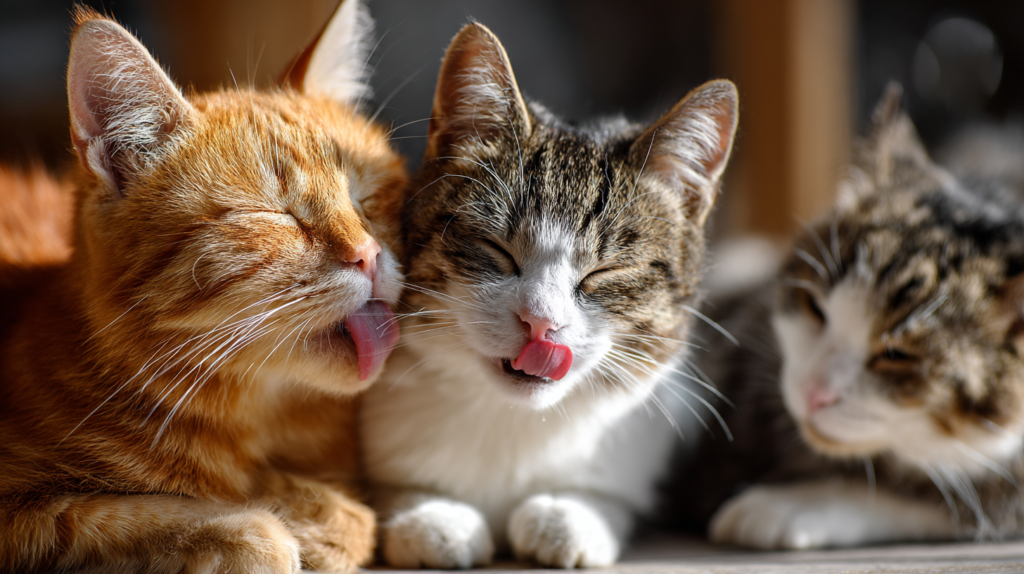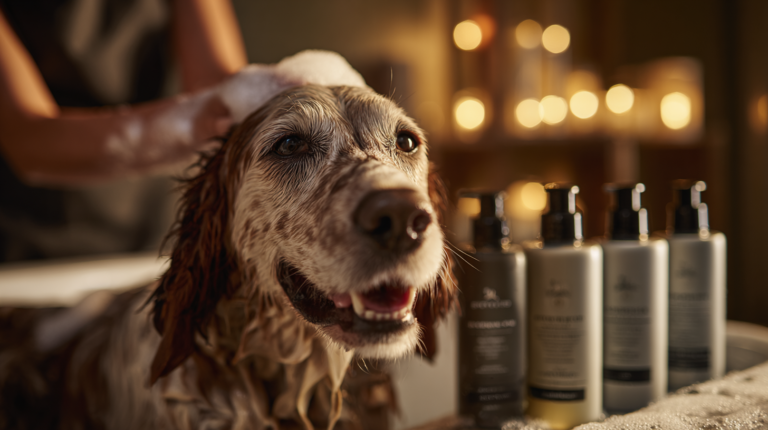Discover Why Do Cats Lick Me their owners! Learn 9 fascinating reasons behind this loving behavior, from affection to grooming instincts. Expert veterinary insights included.
Table of Contents
Does your feline friend regularly give you sandpaper kisses with their rough tongue? You’re not alone! According to recent veterinary behavior studies, over 85% of cat owners report being licked by their pets regularly. This endearing behavior often leaves pet parents wondering: why do cats lick me?
Understanding Why Do Cats Lick Me their human companions reveals fascinating insights into feline psychology, social bonding, and natural instincts. Whether your cat gives you gentle licks during cuddle sessions or enthusiastic grooming sessions that leave your skin tingling, each lick carries meaning in the complex world of cat communication.
As professional pet behaviorists and veterinarians consistently observe, cat licking behavior stems from multiple deep-rooted instincts and emotional connections. From expressing pure affection to following ancient grooming rituals, your cat’s licking behavior is a window into their inner world and their special relationship with you.
Understanding the Science Behind Cat Licking Behavior

Before diving into the specific reasons Why Do Cats Lick Me their owners, it’s essential to understand the anatomy and psychology behind this behavior. A cat’s tongue contains backward-facing hooks called papillae, which serve multiple purposes in the wild and domestic settings.
These specialized structures help cats groom themselves efficiently, remove loose fur, and even assist in feeding. When your cat uses this remarkable tool on you, they’re employing the same mechanisms they use for essential survival behaviors.
Dr. Sarah Martinez, a certified veterinary behaviorist, explains: “Cat licking is a complex behavior that combines instinct, emotion, and communication. When cats lick their owners, they’re often expressing multiple feelings simultaneously.”
The 9 Main Reasons Why Do Cats Lick Me Their Owners
1. Expressing Deep Affection and Love
The most heartwarming reason cats lick their owners is pure affection. When cats lick you, they’re often showing the same love they would demonstrate to their feline family members. This behavior mirrors how mother cats groom their kittens and how bonded cats groom each other in social groups.
Cats view their human family as part of their social circle, and licking serves as their primary way of showing care and attachment. If your cat seeks you out specifically for licking sessions, consider it a high honor – you’ve earned their trust and love.
Signs your cat’s licking is affection-based include:
- Purring while licking
- Gentle, rhythmic licking patterns
- Relaxed body posture
- Kneading with their paws simultaneously
- Choosing quiet, comfortable moments for licking
2. Following Natural Grooming Instincts
Cats are meticulous groomers by nature, spending 30-50% of their waking hours cleaning themselves. When cats lick their owners, they’re often extending this grooming behavior to their human “family members.”
This grooming instinct is so strong that cats will attempt to “help” clean their owners, especially areas they can easily reach like hands, arms, or face. Your cat may focus on spots where they detect interesting scents or tastes, such as:
- Saltiness from perspiration
- Lotion or soap residues
- Food scents on your hands
- Natural skin oils
This behavior demonstrates that your cat considers you part of their social group worthy of grooming attention.
3. Seeking Attention and Interaction
Smart cats quickly learn that licking their owners often results in attention, petting, or interaction. If your cat licks you and you respond with talking, petting, or picking them up, they’ve successfully trained you to give them attention on demand.
This attention-seeking behavior is particularly common in:
- Highly social cat breeds like Siamese or Ragdolls
- Cats who spend long periods alone during the day
- Young cats learning how to communicate with their owners
- Cats who have learned that licking gets immediate responses
To distinguish attention-seeking licking from affectionate licking, observe whether your cat stops licking when you don’t respond or becomes more persistent when ignored.
4. Marking Territory and Claiming Ownership
Cats have scent glands in their tongues and mouths, making licking an effective way to mark territory. When your cat licks you, they’re depositing their scent and essentially claiming you as “theirs.”
This territorial marking behavior is especially noticeable:
- After you’ve been away from home
- When you’ve interacted with other animals
- During times when your cat feels their territory is threatened
- In multi-pet households where competition exists
This type of licking is actually a compliment – your cat is proudly announcing to the world (and other pets) that you belong to them.
5. Communicating Stress or Anxiety
Sometimes, excessive licking can indicate stress or anxiety in cats. While occasional licking is normal and healthy, compulsive licking behaviors may signal underlying emotional issues.
Stress-related licking often appears as:
- Repetitive, intense licking sessions
- Licking that seems urgent or frantic
- Licking accompanied by other stress signs like hiding or decreased appetite
- Sudden increases in licking frequency
Common stress triggers that might increase licking include:
- Changes in household routine
- New pets or family members
- Moving to a new home
- Loud noises or environmental changes
- Medical issues causing discomfort
6. Exploring Taste and Scent
Cats have an incredible sense of taste and smell, and they often lick their owners to explore interesting flavors and scents. Your skin naturally carries various tastes and odors that fascinate cats.
Common tastes that attract cats include:
- Salt from natural perspiration
- Traces of food on your hands
- Soap, lotion, or perfume residues
- Natural skin oils and pheromones
This exploratory licking is usually brief and focused on specific areas where interesting scents are detected.
7. Demonstrating Social Bonding
In cat colonies and multi-cat households, mutual grooming (called allogrooming) strengthens social bonds between cats. When your cat licks you, they’re treating you as a valued member of their social group.
This social bonding behavior indicates:
- High trust levels between cat and owner
- Recognition of you as family
- Desire to maintain close relationships
- Comfort and security in your presence
Cats who engage in social bonding licking often also enjoy being petted and will reciprocate affection when their owners show them attention.
8. Seeking Comfort and Security
Some cats lick their owners as a self-soothing behavior that provides comfort and security. This is particularly common in cats who were separated from their mothers too early or who have experienced trauma.
Comfort-seeking licking often includes:
- Licking combined with kneading motions
- Purring during licking sessions
- Seeking out soft fabrics or clothing while licking
- Licking during quiet, peaceful moments
This behavior helps cats feel safe and secure, similar to how they felt when being groomed by their mothers as kittens.
9. Showing Submission and Respect
In some cases, cats lick their owners as a sign of submission and respect. This behavior acknowledges the owner’s dominant position in the household hierarchy while maintaining the social bond.
Submissive licking is characterized by:
- Gentle, non-persistent licking
- Relaxed body posture
- Accepting of being petted or handled during licking
- Occurring during calm, peaceful interactions
This type of licking demonstrates your cat’s trust in your leadership and their contentment with the relationship dynamic.
When Cat Licking Becomes Concerning
While cat licking is generally normal and healthy behavior, certain patterns can indicate problems that require attention:
Excessive or Compulsive Licking
If your cat’s licking becomes obsessive or compulsive, it may indicate:
- Stress or anxiety disorders
- Boredom or lack of environmental enrichment
- Medical issues causing discomfort
- Behavioral problems requiring intervention
Aggressive or Painful Licking
Licking that becomes rough, aggressive, or painful may signal:
- Overstimulation or frustration
- Territorial disputes in multi-pet homes
- Medical issues affecting behavior
- Inappropriate play behavior that needs redirection
Sudden Changes in Licking Patterns
Dramatic increases or decreases in licking behavior warrant attention:
- Sudden onset of excessive licking
- Complete cessation of previously normal licking
- Changes in licking location or intensity
- Licking accompanied by other behavioral changes
How to Respond to Your Cat’s Licking
Encouraging Positive Licking Behavior
To support healthy licking behavior:
- Remain calm and still during gentle licking sessions
- Offer quiet praise or gentle petting
- Avoid sudden movements that might startle your cat
- Allow your cat to initiate and end licking sessions naturally
Setting Appropriate Boundaries
When licking becomes excessive or uncomfortable:
- Gently redirect your cat’s attention to appropriate activities
- Use positive reinforcement to reward good behavior
- Avoid harsh punishment that might increase anxiety
- Provide alternative outlets for your cat’s energy and attention
Creating a Positive Environment
Support healthy cat behavior by:
- Maintaining consistent daily routines
- Providing adequate mental and physical stimulation
- Ensuring your cat has safe, comfortable spaces
- Addressing potential stressors in the environment
Common Myths About Cat Licking Debunked
Myth 1: Cats Only Lick When They Want Something
Reality: While cats may lick to seek attention, they also lick to show affection, bond socially, and express comfort. Many licking behaviors are purely emotional rather than goal-oriented.
Myth 2: Cat Licking Is Always Sanitary
Reality: While cats maintain excellent personal hygiene, their mouths can carry bacteria. Pet owners should wash hands after extensive licking sessions, especially before eating or touching their faces.
Myth 3: All Cats Lick the Same Amount
Reality: Licking frequency varies greatly between individual cats, breeds, and personalities. Some cats are naturally more affectionate and demonstrative, while others show love through different behaviors.
Expert Tips for Cat Owners
Understanding Your Cat’s Licking Patterns
Keep a simple log of your cat’s licking behavior to identify patterns:
- Times of day when licking occurs most frequently
- Triggers that seem to increase licking behavior
- Your cat’s mood and energy levels during licking
- Environmental factors that might influence the behavior
Promoting Healthy Cat Behavior
Support your cat’s emotional well-being by:
- Providing regular play sessions and mental stimulation
- Maintaining consistent feeding and interaction schedules
- Creating quiet, safe spaces for your cat to retreat when needed
- Addressing any environmental stressors promptly
Building Stronger Bonds
Strengthen your relationship with your cat through:
- Respecting their boundaries and preferences
- Learning to read their body language and signals
- Providing appropriate responses to their communication attempts
- Showing consistent, gentle affection
For more expert pet care tips and product recommendations, visit BlithePet.com — your trusted source for pet wellness.
When to Consult a Veterinarian
While most cat licking is normal behavior, certain situations require professional guidance:
Immediate Veterinary Attention Needed
Seek prompt veterinary care if your cat exhibits:
- Sudden, dramatic changes in licking behavior
- Licking combined with signs of illness (lethargy, appetite loss, vomiting)
- Aggressive or painful licking that causes injury
- Compulsive licking that interferes with eating, sleeping, or normal activities
Behavioral Consultation Recommended
Consider consulting a veterinary behaviorist for:
- Persistent anxiety-related licking
- Licking problems that don’t respond to basic management
- Complex behavioral issues involving multiple pets
- Stress-related behaviors that impact quality of life
Creating the Perfect Environment for Your Cat
Environmental Enrichment
Provide your cat with:
- Multiple scratching posts and climbing structures
- Interactive toys and puzzle feeders
- Comfortable resting areas in various locations
- Access to windows for environmental stimulation
Stress Reduction Strategies
Minimize stress in your cat’s environment by:
- Maintaining predictable daily routines
- Providing multiple resources (food, water, litter boxes) in multi-cat homes
- Using calming pheromone diffusers if needed
- Ensuring adequate personal space and hiding spots
Supporting Natural Behaviors
Allow your cat to express natural behaviors through:
- Regular interactive play sessions
- Opportunities for hunting and stalking (toy mice, laser pointers)
- Access to appropriate scratching surfaces
- Respect for their grooming and resting schedules
The Benefits of Understanding Cat Licking
Strengthened Human-Cat Bond
When you understand Why Do Cats Lick Me, you can:
- Respond appropriately to their communication
- Build deeper trust and affection
- Recognize when they need comfort or attention
- Appreciate the special relationship you share
Early Problem Detection
Monitoring your cat’s licking behavior helps you:
- Identify potential health or behavioral issues early
- Track changes that might indicate stress or illness
- Provide appropriate care and intervention when needed
- Maintain your cat’s overall well-being
Enhanced Pet Ownership Experience
Understanding cat behavior leads to:
- More satisfying interactions with your pet
- Better communication and mutual understanding
- Reduced stress for both you and your cat
- A more harmonious household environment
Educational Table:
Markdown Version:
| Licking Behavior Type | Common Triggers | Signs to Watch For | Recommended Response |
|---|---|---|---|
| Affectionate Licking | Quiet bonding time, after owner returns home | Purring, relaxed posture, gentle rhythm | Accept calmly, offer gentle petting |
| Grooming Instinct | Detecting scents/tastes on skin | Focused on specific areas, methodical approach | Allow briefly, redirect if excessive |
| Attention-Seeking | When owner is busy or distracted | Persistent licking, stops when ignored | Provide attention on your terms |
| Territorial Marking | After contact with other animals | Licking after sniffing, claiming behavior | Normal response, shows bonding |
| Stress/Anxiety | Environmental changes, new situations | Excessive, frantic licking patterns | Address underlying stressors |
| Taste Exploration | Interesting scents on hands/skin | Brief, investigative licking | Normal behavior, ensure safe substances |
| Social Bonding | During calm, peaceful interactions | Mutual grooming attempts, reciprocal behavior | Encourage positive interactions |
| Comfort-Seeking | When cat feels insecure or tired | Combined with kneading, purring | Provide comfort and security |
| Submissive Respect | During handling or training | Gentle, non-persistent licking | Acknowledge with calm praise |
FAQ Section :
Q: Why Do Cats Lick Me so much?
A: Cats lick their owners for multiple reasons including showing affection, following grooming instincts, seeking attention, or marking territory. Excessive licking may indicate stress, anxiety, or medical issues that require veterinary attention.
Q: Is it normal for cats to lick their owners’ faces?
A: Yes, face licking is normal cat behavior. Cats often lick faces because they detect interesting scents, show affection, or follow social bonding instincts. However, be aware that cat saliva can carry bacteria, so wash your face afterward.
Q: Why does my cat lick me then bite me?
A: Licking followed by biting often indicates overstimulation, playfulness, or frustration. This behavior pattern suggests your cat may be overwhelmed by interaction or trying to initiate play. Give your cat space when this occurs.
Q: Should I let my cat lick me?
A: Gentle, occasional licking is generally safe and normal. However, wash your hands afterward and avoid letting cats lick open wounds or your face extensively. Stop the behavior if it becomes excessive or painful.
Q: Why does my cat only lick certain family members?
A: Cats often show preferences based on bonding strength, scent familiarity, or individual relationships. The person who feeds, plays with, or spends the most time with the cat typically receives more licking attention.
Q: Can cat licking be a sign of illness?
A: Sudden changes in licking behavior can indicate health issues. Excessive licking may signal stress, anxiety, or medical problems, while decreased licking might indicate illness or pain. Consult a veterinarian for significant behavioral changes.
Q: How can I stop my cat from licking me excessively?
A: Redirect excessive licking by providing alternative activities, addressing underlying stress, maintaining consistent routines, and avoiding reinforcement of the behavior. If the problem persists, consult a veterinary behaviorist.
Conclusion
Understanding why cats lick their owners opens a window into the complex, fascinating world of feline behavior and emotion. From expressing pure love and affection to following deep-rooted grooming instincts, each lick carries meaning and strengthens the special bond between cats and their human families.
Whether your cat gives you gentle morning kisses or enthusiastic grooming sessions, recognize these moments as precious expressions of trust, love, and social connection. By understanding the reasons behind this behavior, you can respond appropriately and nurture an even stronger relationship with your feline companion.
Remember that every cat is unique, and their licking patterns will reflect their individual personality, experiences, and relationship with you. Pay attention to your cat’s specific behaviors, respond with patience and understanding, and cherish these special moments of connection.
Most importantly, if you notice any concerning changes in your cat’s licking behavior, don’t hesitate to consult with a veterinarian or pet behaviorist. Professional guidance ensures your cat’s health and happiness while strengthening the wonderful bond you share.
Have a similar experience with your pet? Share it in the comments below! Don’t forget to check out our other helpful guides at BlithePet.com for more expert pet care advice and tips.







